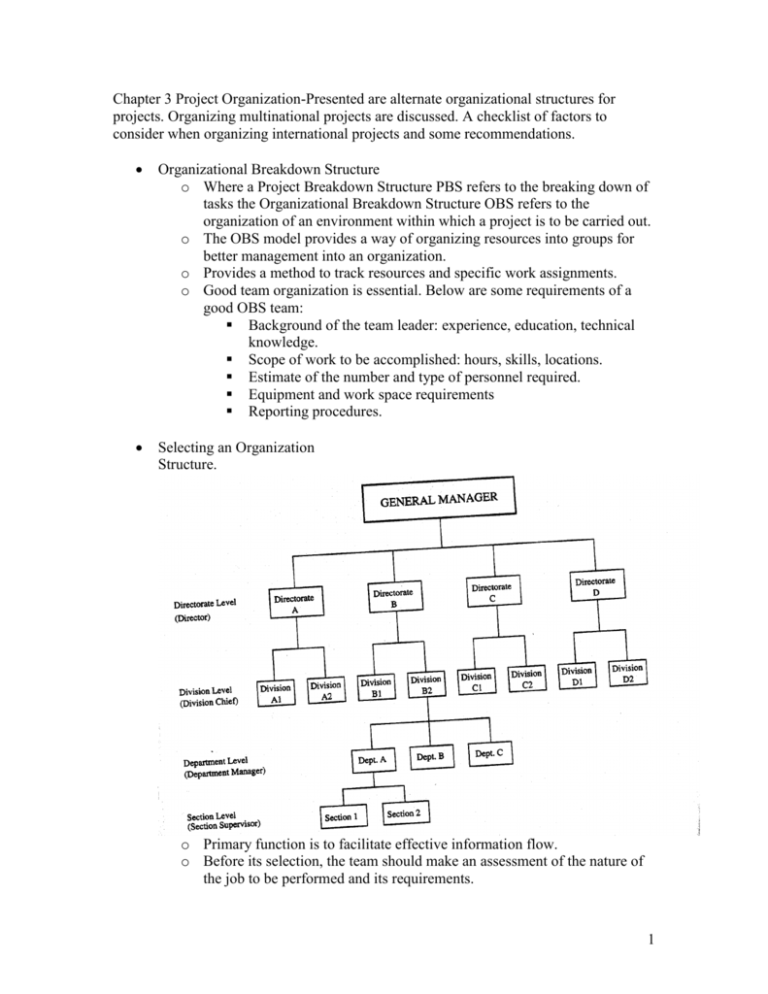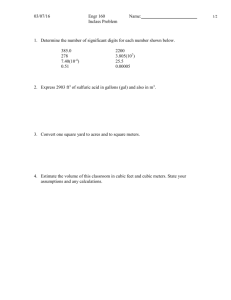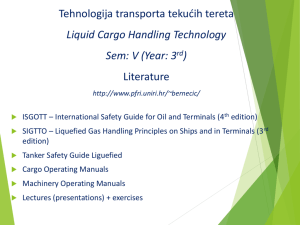Chapter 3 Project Organization
advertisement

Chapter 3 Project Organization-Presented are alternate organizational structures for projects. Organizing multinational projects are discussed. A checklist of factors to consider when organizing international projects and some recommendations. Organizational Breakdown Structure o Where a Project Breakdown Structure PBS refers to the breaking down of tasks the Organizational Breakdown Structure OBS refers to the organization of an environment within which a project is to be carried out. o The OBS model provides a way of organizing resources into groups for better management into an organization. o Provides a method to track resources and specific work assignments. o Good team organization is essential. Below are some requirements of a good OBS team: Background of the team leader: experience, education, technical knowledge. Scope of work to be accomplished: hours, skills, locations. Estimate of the number and type of personnel required. Equipment and work space requirements Reporting procedures. Selecting an Organization Structure. o Primary function is to facilitate effective information flow. o Before its selection, the team should make an assessment of the nature of the job to be performed and its requirements. 1 o Traditional organization structure is one that is still used by many organizations today. Some of the positive attributes are: Availability of broad personnel base. Identifiable technical line of control. Grouping of specialist to share knowledge. Collective line of responsibility. Possible assignment of personnel to several different projects. Clear hierarchy for supervision. Continuity and consistency of functional disciplines. Possibility for departmental policies, procedures, and missions. o Some negative attributes: No one individual is directly responsible for the total project. Project-oriented planning may be impeded. There may not be clear line of reporting up from the lower levels. Coordination is complex. A higher level of cooperation is required between adjacent levels. The strongest functional group may wrongfully claim project authority. Formal Versus Informal Structure o Both structures are practiced in every project environment. o Informal structure develops when people organize themselves in an unofficial way to work towards an objective. Can be subtle, i.e., not everyone is aware of its existence. A functional area that may appear as a formal structure may have some informal elements. o Formal is the officially sanctioned structure. 2 Span of Control The span of management (control) can be wide or narrow. o Wide span of management permits several subordinate units report to the same boss. Can be effective in a favorable project environment. Workers tend to relate better with upper management because of fewer layers. More economical because of fewer layers of supervisors or middle managers. More professional growth because workers have more responsibilities. o Narrow span of management in an organization is beneficial where there are several mutually exclusive skill levels. o Influences that decide a type of control Level of planning required. Level of communication desired. Effectiveness of delegating authority. Dynamism and nature of the subordinate’s job. (Type A personality, low skill, high skill) Competence of the subordinate in performing their job. 3 Functional Organization. A formal org. is a.k.a. functional org. whereby people are organized into groups dedicated to particular functions. Projects that are organized along functional lines are normally resident in a specific department or area of specialization, i.e. manufacturing operations are under the control of the vice president of manufacturing. o Advantages: Improved accountability Discernible line of control Flexibility in manpower utilization Enhanced comradeship of technical staff Improved productivity of specially skilled personnel Potential for staff advancement along functional path Use of the company home office can serve as a refuge for project problems. o Disadvantages of functional organization structure: Divided attention between project goals and regular functions Conflict between project objectives and regular functions Poor coordination of similar project responsibilities Unreceptive attitude by the surrogate department Multiple layers of management Lack of concentrated effort 4 Table 3-1 shows a comparison of the views of the functional and project environments. Though it is difficult to sometimes separate a project environment from the traditional functional environment there must be integration. Product Organization. This approach organizes a project to use the end product or goal of the project as the determining factor for personnel structure. You have a unique entity within a parent organization. It has a dedicated staff and administration focused on the mission. Linked to the parent via progress reports, policies, procedures and funding. o Advantages are: Simplicity of structure Unity of project purpose Localization of project failures Condensed and focused communication lines Full authority in the project manager Quicker decisions due to a centralized authority Skill development due to project specialization Improved motivation, commitment and concentration Flexibility in determining time, cost and performance trade-offs Accountability of project team to one boss (project manager) Individual acquisition and maintenance of expertise on a given project o Disadvantages are: Narrow view of project personnel (as opposed to global organization view) 5 Mutually exclusive allocation of resources (one man to one project) Duplication of efforts on different but similar projects Monopoly of organizational resources Concern about life after the project Reduced skill diversification Matrix Organization Structure- exists where there are multiple managerial accountability and responsibility for a job function. It combines the advantages of traditional structure (time and schedule are sacrificed) and the product organization structure (limited technology utilization and resource sharing because no single group is responsible for overall project planning). The project manager has total responsibility for the project success. The functional managers have the responsibility to achieve and maintain high technical performance of the project. o Advantages: Good team interation Consolidation of objectives Multilateral flow of information Lateral mobility for job advancement Opportunity to work on a variety of projects Efficient sharing and utilization of resources 6 Reduced project cost due to sharing of personnel Continuity of functions after project completion Stimulating interactions with other functional teams Cooperation of functional lines to support project efforts Home office for personnel after project completion Equal availability of company knowledge base to all projects. o Disadvantages: Slow matrix response time for fast paced projects Independent operation of each project organization High overhead cost due to additional lines of command Potential conflict of project priorities Problems of multiple bosses Complexity of structure Mixed Organization Structures is a combination of the functional, product and matrix structures. An advantage is better flexibility in a special problem situation and that it can adapt to the needs of the project and a disadvantage difficulty in identifying responsibility within a project New Organization Structures. Bubble, Market, Chronological, Sequential. 7 Organizing Multinational Projects o Some considerations: Product Technology Political and Social Environment Labor Market Plant and residential amenities Financial Services o Case Study- A large scale international project that consists of the engineering, procurement, and construction of 7 liquid natural gas (LNG) tanks together with their ancillary system and control building in a Middle Eastern country. The requirements are as follows: 3 LNG tanks of 80,000 cubic meters each 2 LPG propane tanks of 50,000 cubic meters each 8 2 LPG butane tanks of 50,000 cubic meters each The ancillary system which are part of the project include: 1 propane and butane vapor recovery system 1 low pressure flare system 1 offsite control room Project Setting Technical Requirements Organizational Relationships Safety and Environmental Considerations Analysis of project scenario Sources of possible problems Parent-Child relationship Too many companies involved Communications Population increase Logistics Factors to consider and suggestions from the author Strategic Planning Cost/Benefit Analysis 9 Technology Assessment Acquisition Trade Agreements Different Labor Practices Different Governmental and Political Ideologies Information Management Recommendations Simplify the levels of responsibilities by contracting with fewer companies. Minimize the interdependencies of companies by using nonsubsidiary companies. Predetermine communication time zones that are compatible with the timing of project decisions. Reevaluate the level of technology required for the project. Arrange for special favorable trade exceptions to facilitate movement of personnel and materials. 10








